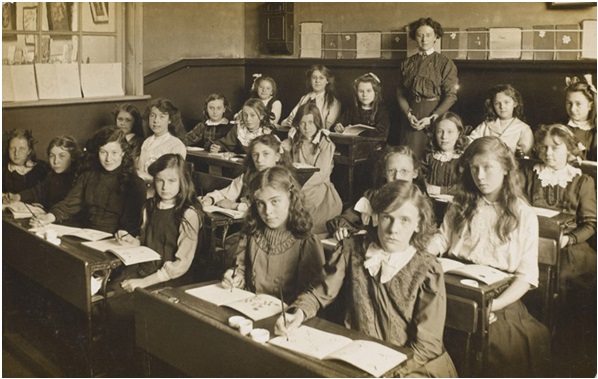Victorian Era is a period in British history that refers to the reign of Queen Victoria, namely from 1837 and up to 1901. This prominent time is characterised by rapid changes in social life, politics, science and, of course, literature. As for the literary tradition, there are several features that need to be mentioned.
1) Turn to the Romantic tradition
Although the focus on reality best describes this period, there was a turn to a Romantic past with its symbolism and quite dark themes.
2) Interest in Myth
Poets and novelists got interested in folklore and medieval myths. They used the themes of knights and courtly love.
3) Scepticism and Realism
The poetry was not as idealised as it used to be in the past tradition. In this period, the tendency was up to realism and everyday life. There was also a turn to the themes of city life and urbanization.
4) Questioning the Church
With the development of the empirical knowledge and rationalism, people started to question not only the existence of God but also the morality of the religious institutions and the priests.
5) Belief in Science and Technology
The science was developing quite dramatically, and the crucial idea was that it could solve almost any problem. Education became even more important, and lots of people got interested in new technologies.
So if you need to write an essay and don’t know where to start from, here’s a list of 8 splendid poems. They will not only give you the pleasure of reading but will also reflect the era in the best possible manner.
1. Elizabeth Barrett Browning‘s “How Do I Love Thee”
This sonnet is famous even today because it depicts the love and purity of this feeling. It is written in a simple yet beautiful language to show the depth of the feeling. It is not a surprise that even today lots of couples find it close to their hearts and use it to illustrate their love for each other.
2. Alfred Tennyson’s “Ulysses”
The main theme of this poem is growing old. The name refers to the classic myth of Ulysses that returned from the Trojan War. One of the most exciting features of this literary work is the use of the dramatic monologue that became quite a popular thing in Victorian poetry.
Lord Tennyson is known to be one of the first to use it in his poetry. The lyrical hero of the poem remembers the old days of glory and experiences the melancholy of the battles and adventures that are now only in memory.
3. Anne Brontë’s “Night”
The youngest representative of the Brontë literary family has shown an extraordinary talent when it comes to poetry. “Night” is a classic example of her realistic and a bit pessimistic style that deals with feeling and romance.
It depicts the specific feeling that night brings to the narrator – a solitude comfort. Although this work uses a complex rhythm structure, it is quite short and seems simple.
The author dwells on the themes of night, dream and reality over illusion, creating a very distinctive metaphor.
4. Gerard Manley Hopkins’ Pied Beauty
Hopkins was not only a writer but also a priest; therefore, his works are full of religious symbolism. It is quite contradictory with the mainstream Victorian ideas, and that’s why it is so fascinating to read.
This is reduced sonnet that states new forms of rhythm and metre to bring the fresh look on the classic tradition. The narrator looks at the beautiful nature to see its pattern as God’s prominent will and design.
5. Thomas Hood’s “I Remember, I Remember”
Hood is not as well known today as he used to be, but this particular poem still has its plays in many students’ hearts. It is a simple and repetitive poem that uses quite a straightforward language.
The main theme is remembering the childhood years and the beauty of a child’s ignorance when everything seems so magical and simple. There is also a bit dark undertone to it as the poet compares the past to the present day.
The knowledge that he got while growing up didn’t make him happier or wiser than he was before.
6. Christina Rossetti’s “A Birthday”
This is a joyful and very bright poem, which is not very characteristic of other Rossetti’s literary work. It deals only with a pure feeling of happiness and its celebration. Narrator celebrates the birth of her love and compares her soul with an apple-tree that is bending because of all of the fruit it gives.
The innovation is in the irregular rhythm pattern that can be seen in two stanzas.
7. Oscar Wilde’s “My Voice”
The fame came to Oscar Wilde with his novels, but his poetry is also worth reading as it shows his talent and unique style. Through the complex structure of the poem, the author examines the themes of lost love and how it fades away.
Starting from a joyful depiction, the tone quickly changes – the love is lost and can never be here again. The narrator also mourns that for the loved one it will only be a dream that can be easily put aside and there is nothing left.
8. Thomas Hardy’s “The Walk”
This is a nostalgic poem written after the death of his first wife, Emma. The main theme is reliving with the past and the sombre nostalgia of the old days that cannot be shared with her anymore. The narrator describes as they used to walk in the countryside before and how it all changed.
Then his wife was weak, and she couldn’t accompany him, but he didn’t think of her as “left behind”. But now she is gone, and there is only a memory of the past. Hardy manages to set a nostalgic but not tragic tone, and the last line can even seem as lacking emotions. This allows readers to give their own interpretation of the poem.
